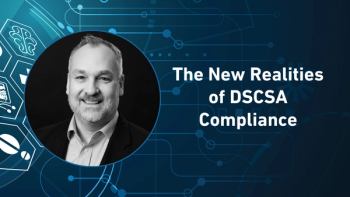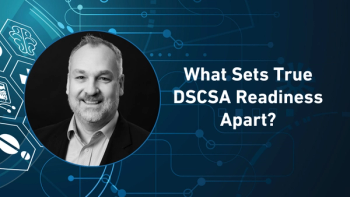
A Change of Pace for Accessing Specialty Medications – Access for More Patients
Sponsored by McKesson
Among ~5.8 billion prescriptions filled each year, about 2 percent (or 116 million) are written for specialty therapies.[1] These medications can be highly complex and significantly more expensive than traditional pharmaceuticals – presenting patients with some of the most difficult prescription access challenges in health care.
Compared to conventional medications, patients and providers must complete additional clinical and administrative requirements before specialty medications can be dispensed or reimbursed. Complicated workflows, along with back and forth transactions among health care stakeholders, can leave patients struggling to get the therapies they need.
AMP changes the way providers and patients experience support services for specialty medications. At each stage of the specialty workflow, AMP creates efficiencies and applies network solutions to overcome long-standing challenges.
Support Challenges
Support programs serve as an important resource for patients beginning a specialty therapy by providing services to help with medication access, affordability and adherence. Enrolled patients are connected with financial assistance programs, receive education on their therapies and obtain the help needed to coordinate care.[2] While support services lend a much needed helping hand, a survey of 10,000 patients across several therapeutic areas found that only one in five were aware of such programs.[2] For many patients, this means their only chance of connecting with a support program is through their provider.
To enroll patients in support services, providers must be aware that a program exists for a given specialty medication and locate the correct enrollment form. After completing the form, providers have traditionally faxed it to the appropriate organization for processing (i.e., pharmaceutical manufacturer, specialty pharmacy or hub provider).[3] Alternatively, enrollment via web portals is sometimes available, but it’s up to providers to remember individual login credentials for each program, which can be difficult information to keep track of.[4] It’s estimated that less than 10 percent of patient enrollment for specialty support services is completed electronically.[5]
Specialty Prescribing & Enrollment
AMP is revolutionizing patient access to support services for specialty medications by linking together two major steps in the specialty workflow: prescribing and enrollment. Technology innovation and key network connections allow AMP to funnel enrollment through the point of prescribing to give all patients the opportunity to experience support services. Through AMP, specialty medications can be e-prescribed to a non-dispensing pharmacy, such as ScriptHero Pharmacy, which can serve as the central location for all specialty prescriptions. Behind the scenes, AMP fulfills all the complex requirements (e.g., benefits investigation (BI), benefits verification (BV), prior authorization (PA), lab scheduling, prescription titration, etc.) for starting patients on therapy, while the non-dispensing pharmacy triages prescriptions to the appropriate specialty pharmacy in a given limited distribution network for dispense to patients.
Industry-wide, the standard for specialty prescribing and enrollment has involved paper, phone and fax-based processes. Not only are phone calls and faxes outdated methods of communication – contributing to office inefficiencies for providers and their staff – there is little direction for where specialty prescriptions must be sent. As a result, more than 40 percent of faxed specialty prescriptions require call back to the provider.[5] In addition, more than 85 percent of surveyed providers reported a lack of digital access to specialty pharmacy information within their EHR systems for where to send prescriptions.[6] AMP overcomes this challenge as providers only need to prescribe to a central, non-dispensing pharmacy, like ScriptHero Pharmacy, for specialty prescriptions to be processed and sent to the right location for dispense.
To meet providers where they are, AMP allows for enrollment into support services to be completed in multiple other ways as well. As soon as an e-prescription for a specialty medication is written, enrollment can be automatically triggered within the familiar CoverMyMeds web portal, which is already used by over 700,000 providers for submitting prior authorization (PA) requests electronically.[7] In fact, data from a recent two-month
As an added benefit, patient information from an e-prescription is auto-populated directly into the enrollment form, helping providers to save time. If the medication is not e-prescribed, providers can also choose to manually start enrollment within the CoverMyMeds portal or use more traditional methods, like phone or fax, to complete enrollment.
Coordinating Care
For many patients, the reimbursement component of starting specialty therapy is most challenging. Knowing who to contact for answers and assistance can be difficult even for health care experts, let alone struggling patients. In fact, some patients have described working through these activities on their own as a full-time job.[9] Reimbursement involves processes like BI, BV and PA which require information transfer among patients, providers, pharmacies and payers. When multiple health care stakeholders are needed to coordinate reimbursement activities, it typically takes more time to facilitate patient care.
AMP is changing the way care is coordinated with an online self-service dashboard that facilitates workflow organization and efficiency. Stakeholders are alerted to outstanding steps along with who is responsible for completion. Through such network connectivity, AMP can increase workflow visibility and transparency among members of the patient care team while allowing for real-time transfer of pertinent information to help prevent delays in time-to-therapy.
Complicated insurance-related requirements, like BI, BV and PA are available for electronic fulfillment through AMP and fit within a standardized workflow to help improve efficiency and decrease time-to-therapy. In the past, these steps required weeks to fulfill – delaying time-to-therapy by eight weeks in some cases. In the recent AMP pilot study, all three of these major reimbursement activities were completed in a total of 11 days on average.[8]
Exception Management & Outcomes
As specialty medications exist on a spectrum of complexity, every patient case may not be amendable to the standard workflow. These exceptions are managed by a highly skilled team of case managers that work quickly to resolve outstanding issues. After therapy begins, AMP case managers continue supporting positive outcomes through regular check-ins and communication with patients to help them remain on therapy.
Specialty medications are bringing hope to many patients suffering from difficult-to-treat conditions and rare diseases, but access barriers can stand in the way of wellness. AMP addresses the challenges confronting patients at each stage of their journeys, from access to adherence. To learn more about how AMP is providing patients with the end-to-end support needed for specialty therapies, visit
SOURCES
- Medicine Use and Spending in the U.S., A Review of 2017 and Outlook to 2022, IQVIA Institute, 2018, accessed at https://www.iqvia.com/insights/the-iqvia-institute/reports/medicine-use-and-spending-in-the-us-review-of-2017-outlook-to-2022.
- Patient Services – Pharma’s Best Kept Secret, Accenture Life Sciences, 2016, accessed at https://www.accenture.com/_acnmedia/accenture/next-gen/patient-services-survey/accenture-mc814-patient-servicesls-research-note2015-v7.pdf.
- HIT Perspectives: Automating Enrollment for Specialty Prescriptions, Point of Partners, 2017, accessed at https://www.pocp.com/hit-perspecitves-automating-enrollment-specialty-prescriptions/.
- Simplifying HCP Access to Digital Information, PMLiVE, 2018, accessed at http://www.pmlive.com/pharma_intelligence/simplifying_hcp_access_to_digital_information_1216451
- Automating Specialty Pharmacy: Identifying Gaps, NCPDP, 2015, accessed at https://pocp.com/wp-content/uploads/PDF/6-%20NCPDP_2015_ED_Summit_SpecialtyRx.pdf
- Specialty Prescribers Tell All, NCPDP Conference Presentation, 2019, accessed at https://www.pocp.com/wp-content/uploads/NCPDP-AC2019-Specialty-Prescribers-Tell-All-w-ACPE-slides_FINAL_SM.pdf
- A New Starting Point for Patient Support: Technology-Driven Hub Services, Drug Channels, 2019, accessed at https://www.covermymeds.com/main/insights/articles/ms-patient-access-white-paper/
- Access for More Patients Delivers End-to-End Electronic Support for Specialty Medications, CoverMyMeds, 2019
- The Impact of Disease-Modifying Therapy Access Barriers on People with Multiple Sclerosis: Mixed-Methods Study, Journal of Medical Internet Research, 2018, accessed at https://www.jmir.org/2018/10/e11168
Newsletter
Stay ahead in the life sciences industry with Pharmaceutical Commerce, the latest news, trends, and strategies in drug distribution, commercialization, and market access.





